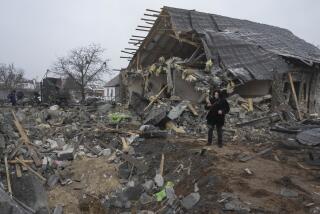Doing Business : The Flavor of Success, and Failure, in Russia : * Ben & Jerry’s opened and is doing well. But another U.S. company hoping to export lumber is not.
- Share via
PETROZAVODSK, Russia — In this quaint lakeside city near the Finnish border, two American businesses sit right across the street from each other. But their experiences in negotiating the tough Russian market could not be more different.
One company is extremely successful, with customers lined up outside the door eight hours a day. The other has yet to cut a major deal after two years of trying.
Taken together, the stories of Vermont ice cream maker Ben & Jerry’s and the Mid-American Russian Corp., or Marco, a Missouri-based lumber company, show why it is so painfully difficult to do business in the former Soviet Union and what it takes to be successful.
Ben & Jerry’s--known for its activist business practices that include giving a share of profit to charity--first considered setting up shop in Russia in 1987. It was inspired to try “ice cream diplomacy” by then-Soviet President Mikhail S. Gorbachev’s perestroika reforms.
But it was three years before the company formed a joint venture, agreeing to open an ice cream factory and parlor in Petrozavodsk, capital of Russia’s Karelia region, 175 miles northeast of St. Petersburg.
Ben & Jerry’s knew that they had a market. Russians are ice cream addicts, known to stand in line for a cone even in the dead of winter. What the Americans did not know was how tricky it would be to get and keep an operation going.
“We quickly learned that to do business here, you can’t just have a Plan A and Plan B. You need Plans C, D, E, F and G,” said Greg Quinn, general director of Ben & Jerry’s Russian operation. “You have to expect things not to go right and then be flexible to take advantage of it.”
“Ben i Dzherris,” as it become known, slowly rented space for its combination cafe-factory, found dependable supply sources for ingredients and taught its staff of 100 the nuances of ice cream making. Its Russian partners are the Pioneer Palace, the youth center where the cafe is located; InterCenter, a cultural exchange organization, and Petrobank, a Petrozavodsk bank.
The retail outlet opened in July, 1992.
“Sure, we had problems. We have problems still, all the time,” Quinn said. On the day that he met with a reporter, for instance, his store had to shut down when the city turned off the water for repairs.
But the hard work is paying off. The factory-cafe and two sales branches now serve more than 6,000 people a day, dishing up two tons of flavors such as “Cherry Garcia” (vanilla ice cream with cherries) and “Karelia Crunch” (cranberry ice cream with chocolate chips).
*
Two scoops in a fresh waffle cone sell for 300 to 500 rubles (about 30 to 50 cents), well within reach of most Karelians. The business is turning a profit, Quinn says, and has expanded into sales of pre-packaged pints and even multi-gallon tubs in Moscow and St. Petersburg.
Like many foreign busineses here, Ben & Jerry’s uses the rubles to pay for ingredients, equipment and salaries in Russia and then wires the excess home. Although rubles aren’t officially convertible, they can be used to buy dollars at Russian banks for wiring back to the United States.
The other American business, Marco, was formed in 1991 by a small group of private investors--most of them lawyers from St. Louis and Kansas City--who saw big potential profit in exporting Russian lumber. Like Ben & Jerry’s, Marco’s investors also had a bigger aim.
“We wanted to help bring Russia back into the mainstream of the world economy,” said Bartow Shaw, a key investor.
It seemed a natural. Karelia, stretching along the Finnish border from just north of St. Petersburg to near the Arctic Circle, has lush forests of pine and birch, with one lake for every five residents. Overall exports from Karelia increased threefold last year over 1991, with paper and timber the leading products.
The first signs for the American lawyers-turned-lumbermen from the Karelian regional government were encouraging. “They were very supportive. If we needed information, if we needed interpretation, if we needed copies of laws, we got it,” Shaw said.
Karelia’s pro-investment attitude may stem from its history as part of Finland and Sweden; signs throughout Karelia are still in both Russian and Finnish.
But although Karelia has taken steps to lure foreign capital, it is very sensitive about industries involving natural resources. “They insisted that everything be on a sustained basis, that you not deplete the forest,” Shaw said.
A government agency and plenty of red tape regulate the export of timber, considered a strategic resource. Ben & Jerry’s was not so burdened, and in Shaw’s words, escaped a “big bureaucratic problem.”
Marco started its activities by searchingKarelia for potential Russian partners, such as lumber mills and furniture factories; Russian law favors joint ventures. That’s when the problems started. Knowing that Marco would be at a disadvantage if it did not find a partner, potential candidates bargained hard.
“When they sat down at the table, the price skyrocketed,” said Howard B. Hacker, Marco’s Petrozavodsk-based executive vice president. The Americans decided it was too expensive for Marco to enter a joint venture. This decision put them at a serious disadvantage. Russian law not only gives joint ventures tax breaks and exemptions from certain laws, but it also significantly eases export quotas for them. As a purely U.S.-owned company, Marco could not get permission from the government to export some ofthe products it hoped to deal in, such as cut lumber boards. Consequently, it has completed only a few small deals.
“When they made laws about foreigners doing business here, they weren’t dumb,” Hacker said. “You just can’t buy lumber and ship it out. You have put some money into a joint venture first.”
Marco is compensating by moving into products that it can get the right to export, such as plywood. But exporting is still tricky. Trucking wood products to Europe is prohibitively expensive, and the Russian ports are crowded and corrupt.
Ben & Jerry’s, in contrast, sells all its products inside Russia. It drives its own refrigerated trucks to Moscow and St. Petersburg, where clients include hard-currency supermarkets, hotels and embassies.
That doesn’t mean it has been as smooth as vanilla for Ben & Jerry’s. The government introduced a law this summer prohibiting domestically made products from being sold wholesale for hard currency. That meant Ben & Jerry’s could no longer sell to its Moscow distributor for dollars. Its distributor quit rather than deal with the uncertainties of the ruble economy, leaving the ice cream maker unable to sell in Moscow for more than six weeks, forfeiting thousands of dollars.
*
The firm discussed a wide range of possible solutions--including trucking ice cream into one of the nearby Baltic countries and then re-importing it to Russia as a “foreign” product--before it found a new distributor, willing to buy wholesale for rubles. The ice cream is still retailed for hard currency.
As a joint venture, Ben & Jerry’s got tax breaks, making its profit tax-free through the end of this year. Foreign-owned Marco, on the other hand, is taxed heavily, paying between 32% and 45% of its profit to the Russian government, depending on the type of deal. High taxes, Shaw said, form only one of the many daunting barriers to foreign businesses.
“The two biggest problems here are, first, problems understanding basic business principles, and second, basic lack of underlying law,” he said in a phone interview from Sumter, S.C. “It’s not clear how soon they can change the laws to create a stable environment for investors.”
In the meantime, Americans in Karelia offer some advice to others hoping to do business in Russia:
First, get a good partner. “Take the time to find somebody you can trust. You’ll make lots of mistakes together,” Quinn said.
Second, don’t expect to make a fortune by Day 2. “You have to have an incredible amount of patience,” Hacker said.
Finally, expect to lay out a chunk of capital. “You have to have a lot of money to invest, so you can lose some money,” he said.
Numbers Crunch
Here is a look at the rate of success enjoyed by Ben & Jerry’s Pioneer Palace ice cream factory in Petrozavodsk, which opened in July, 1992.
Average number of visitors per day, July 1993: 3,300.
More to Read
Inside the business of entertainment
The Wide Shot brings you news, analysis and insights on everything from streaming wars to production — and what it all means for the future.
You may occasionally receive promotional content from the Los Angeles Times.










